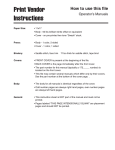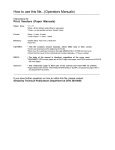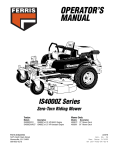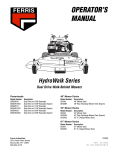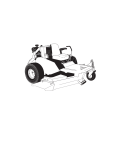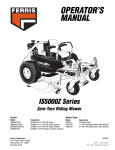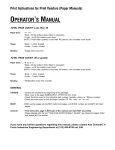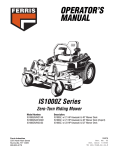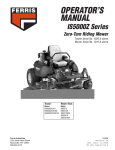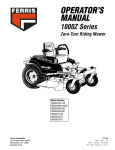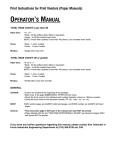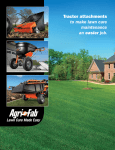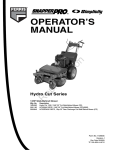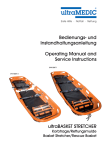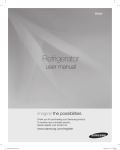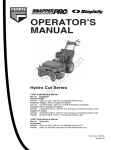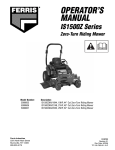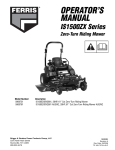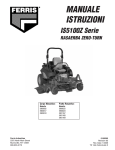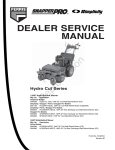Download Ferris Industries BGF48KAV15 User's Manual
Transcript
OPERATOR’S MANUAL UltraBelt GD Series Belt-Drive Walk Behind Mower Beginning S/N: 5409 & above Model Number: BGF36KAV15 BGF48KAV15 Ferris Industries 5375 North Main Street Munnsville, NY 13409 800-933-6175 23230 Revision 02 Rev. Date: 8/2004 TP 100-7131-02-UB-F Table of Contents Safety Rules & Information ................................2 Identification Numbers .......................................7 Features & Controls ............................................8 Regular Maintenance ........................................13 Maintenance Schedule .........................................13 Checking Tire Pressure.........................................13 Checking/Adding Fuel...........................................14 Fuel Filter ..............................................................14 Oil & Filter Change ...............................................14 Check / Change Air Filter......................................14 Lubrication ............................................................15 Servicing the Mower Blades .................................16 Control Functions....................................................8 Safety Interlock System ..........................................9 Operating the Walk Behind Mower ..................10 General .................................................................10 Checks Before Starting .........................................10 Starting the Engine ...............................................10 Driving the Mower .................................................11 Operating On A Slope...........................................11 Stopping the Mower ..............................................11 Mowing..................................................................11 Pushing the Rider by Hand...................................11 Storage..................................................................12 Starting After Long Term Storage .........................12 Troubleshooting, Adjustments & Service .......17 Troubleshooting the Mower ...................................17 Troubleshooting the Mower Deck..........................18 Steering Lever Adjustment....................................19 Brake Adjustment..................................................20 Mowing Height Adjustment ...................................20 PTO Clutch Adjustment ........................................21 PTO Drive Belt ......................................................22 Gearbox Drive Belt................................................23 Lawn Care & Mowing Information .............LC—1 NOTE: In this manual, “left” and “right” are referred to as seen from the operating position. WARNING WARNING You must read, understand and comply with all safety and operating instructions in this manual before attempting to set-up and operate your machine. Engine exhaust from this product contains chemicals known, in certain quantities, to cause cancer, birth defects, or other reproductive harm. Failure to comply with all safety and operating instructions can result in loss of machine control, serious personal injury to you and / or bystanders, and risk of equipment and property damage. The triangle in the text signifies important cautions or warnings which must be followed. 1 Safety Rules & Information Read these safety rules and follow them closely. Failure to obey these rules could result in loss of control of unit, severe personal injury or death to you, or bystanders, or damage to property or equipment. This mowing deck is capable of amputating hands and feet and throwing objects. The triangle in text signifies important cautions or warnings which must be followed. TRAINING OPERATION 1. Read, understand, and follow all instructions in the manual and on the unit before starting. If the operator(s) or mechanic(s) can not read English it is the owner’s responsibility to explain this material to them. 2. Become familiar with the safe operation of the equipment, operator controls, and safety signs. 3. All operators and mechanics should be trained. The owner is responsible for training the users. 4. Only allow responsible adults, who are familiar with the instructions, to operate the unit. 5. Never let children or untrained people operate or service the equipment. Local regulations may restrict the age of the operator. 6. The owner/user can prevent and is responsible for accidents or injuries occurring to themselves, other people or property. 7. Data indicates that operators, age 60 years and above, are involved in a large percentage of riding mower-related injuries. These operators should evaluate their ability to operate the riding mower safely enough to protect themselves and others from serious injury. 1. Never run an engine in an enclosed area. 2. Mow only in the daylight or with good artificial light, keeping away from holes and hidden hazards. 3. Be sure all drives are in neutral and parking brake is engaged before starting engine. Only start engine from the operator’s position. Use seat belts if provided. 4. Be sure of your footing while using pedestrian controlled equipment, especially when backing up. Walk, don’t run. Reduced footing could cause slipping. 5. Slow down and use extra care on hillsides. Be sure to travel in the recommended direction on hillsides. Turf conditions can affect the machines stability. Use caution when operating near drop-offs. 6. Do not mow in reverse unless absolutely necessary. Always look down and behind before and while traveling in reverse. 7. Be aware of the mower discharge direction and do not point it at anyone. Do not operate the mower without either the entire grass catcher or the deflector in place. 8. Slow down and use caution when making turns and when changing directions on slopes. 9. Never raise deck with the blades running. 10. Never leave a running unit unattended. Always disengage the PTO, set parking brake, stop engine, and remove keys before dismounting. Keep hands and feet away from the cutting units. 11. Turn off the PTO switch to disengage the blades when not mowing. 12. Never operate with guards not securely in place. Be sure all interlocks are attached, adjusted properly and functioning properly. 13. Never operate with the discharge deflector raised, removed or altered, unless using a grass catcher. 14. Do not change the engine governor setting or overspeed the engine. 15. Stop on level ground, lower implements, disengage drives, engage parking brake, shut off engine before leaving the operator’s position for any reason including emptying the grass catchers or unclogging the chute. 16. Stop equipment and inspect blades after striking objects or abnormal vibration occurs. Make necessary repairs before resuming operations. 17. Keep hands and feet away from the cutting units. 18. Look behind and down before backing up to be sure of a clear path. 19. Never carry passengers and keep pets and bystanders away. 20. Do not operate the unit while under the influence of alcohol or drugs. 21. Slow down and use caution when making turns and crossing roads and sidewalks. Stop blades if not mowing. 22. Use care when loading or unloading the machine into a trailer or truck. PREPARATION 1. Evaluate the terrain to determine what accessories and attachments are needed to properly and safely perform the job. Use only accessories and attachments approved by the manufacturer. 2. Wear appropriate clothing including safety shoes, safety glasses and ear protection. Long hair, loose clothing or jewelry may get tangled in moving parts. 3. Inspect the area where the equipment is to be used and remove all objects such as rocks, toys and wire, which can be thrown by the machine. 4. Use extra care when handling gasoline and other fuels. They are flammable and vapors are explosive. a) Use only an approved container. b) Never remove fuel cap or add fuel with the engine running. Allow engine to cool before refueling. Do not smoke. c) Never refuel or drain the machine indoors. 5. Check that operator’s presence controls, safety switches and shields are attached and functioning properly. Do not operate unless they are functioning properly. TP 600-7124-03-UV-F 2 Safety Rules & Information 23. Use care when approaching blind corners, shrubs, trees or other objects that may obscure vision. 24. To reduce fire hazard, keep unit free of grass, leaves & excess oil. Do not stop or park over dry leaves, grass or combustible materials. 25. The engine in this unit is not factory equipped with a spark arrester. It is a violation of California Public Resource Code Section 4442 to use or operate the engine on or near any forest-covered, brush-covered, or grass-covered land unless the exhaust system is equipped with a spark arrester meeting any applicable local or state laws. Other states or federal area may have similar laws. 26. OSHA regulations may require the use of hearing protection when exposed to sound levels greater than 85 dBA for an 8 hour time period. Do Not 1. Avoid starting, stopping, or turning on a slope. If tires lose traction (i.e. machine stops forward motion on a slope), disengage the blade(s) (PTO) and drive slow off the slope. 2. Do not turn on slopes unless necessary, and then, turn slowly and gradually uphill, if possible. Never mow down slopes. 3. Do not mow near drop-offs, ditches, or embankments. The operator could lose footing or balance or mower could suddenly turn over if a wheel is over the edge of a cliff or ditch, or if an edge caves in. 4. Do not mow on wet grass. Reduced footing or traction could cause sliding. 5. Do not try to stabilize the unit by putting your foot on the ground. (ride-on units) 6. Do not mow excessively steep slopes. 7. Do not use grass catcher on steep slopes. 8. Do not mow slopes if you cannot back up them. CAUTION This machine produces sound levels in excess of 85 dBA at the operator’s ear and can cause hearing loss though extended periods of exposure. Wear hearing protection when operating this machine. TOWED EQUIPMENT (RIDE-ON UNITS) 1. Tow only with a machine that has a hitch designed for towing. Do not attach towed equipment except at the hitch point. 2. Follow the manufacturer’s recommendations for weight limit for towed equipment and towing on slopes. See attaching a trailer under OPERATION. 3. Never allow children or others in or on towed equipment. 4. On slopes, the weight of the towed equipment may cause loss of traction and loss of control. 5. Travel slowly and allow extra distance to stop. 6. Do not shift to neutral and coast down hill. SLOPE OPERATION Slopes are a major factor related to loss-of-control and tipover accidents, which can result in severe injury or death. All slopes require extra caution. If you cannot back up the slope or if you feel uneasy on it, do not drive on it. WARNING CHILDREN Tragic accidents can occur if the operator is not alert to the presence of children. Children are often attracted to the unit and the mowing activity. Never assume that children will remain where you last saw them. 1. Keep children out of the mowing area and under the watchful care of another responsible adult. 2. Be alert and turn unit off if children enter the area. 3. Before and during reverse operation, look behind and down for small children. 4. Never carry children, even with the blade(s) off. They may fall off and be seriously injured or interfere with safe unit operation. Children who have been given rides in the past may suddenly appear in the mowing area for another ride and be run over or backed over by the machine. 5. Never allow children to operate the unit. 6. Use extra care when approaching blind corners, shrubs, trees, or other objects that may obscure vision. Never operate on slopes greater than 17.6 percent (10°) which is a rise of 3-1/2 feet (106 cm) vertically in 20 feet (607 cm) horizontally. Select slow ground speed before driving onto slope. Use extra caution when operating on slopes with rearmounted grass catchers. Mow across the face of slopes, not up and down,use caution when changing directions and DO NOT START OR STOP ON SLOPE. Do 1. Mow across slopes, not up and down. 2. Remove obstacles such as rocks, tree limbs, etc. 3. Watch for holes, ruts, or bumps. Uneven terrain could overturn the unit. Tall grass can hide obstacles. 4. Use slow speed. Choose a slow speed so that you will not have to stop or change speed while on the slope. 5. Use extra care with grass catchers or other attachments. These can change the stability of the unit. 6. Keep all movement on the slopes slow and gradual. Do not make sudden changes in speed or direction. 7. See your authorized dealer for recommendations of available weights to improve stability. EMISSIONS 1. Engine exhaust from this product contains chemicals known, in certain quantities, to cause cancer, birth defects, or other reproductive harm. 2. Look for the relevant Emissions Durability Period and Air Index information on the engine emissions label. 3 Safety Rules & Information SERVICE AND MAINTENANCE 10. Let engine cool before storing and do not store near flame. 11. Stop and inspect the equipment if you strike an object. Repair, if necessary, before restarting. 12. Park machine on level ground. Never allow untrained personnel to service machine. 13. Use jack stands to support components when required. 14. Carefully release pressure from components with stored energy. 15. Disconnect battery or remove spark plug wire before making any repairs. Disconnect the negative terminal first and the positive last. Reconnect positive first and negative last. 16. Use care when checking blades. Wrap the blade(s) or wear gloves, and use caution when servicing them. Only replace blades. Never straighten or weld them. 17. Keep hands and feet away from moving parts. If possible, do not make adjustments with the engine running. 18. Charge batteries in an open well ventilated area, away from spark and flames. Unplug charger before connecting or disconnecting from battery. Wear protective clothes and use insulated tools. 19. Grass catcher components are subject to wear, damage, and deterioration, which could expose moving parts or allow objects to be thrown. Frequently check components and replace with manufacturer’s recommended parts, when necessary. 20. Check brake operation frequently. Adjust and service as required. 21. Use only factory authorized replacement parts when making repairs. 22. Always comply with factory specifications on all settings and adjustments. 23. Only authorized service locations should be utilized for major service and repair requirements. 24. Never attempt to make major repairs on this unit unless you have been properly trained. Improper service procedures can result in hazardous operation, equipment damage and voiding of manufacturer’s warranty. 25. Units with hydraulic pumps, hoses, or motors: WARNING: Hydraulic fluid escaping under pressure may have sufficient force to penetrate skin and cause serious injury. If foreign fluid is injected into the skin it must be surgically removed within a few hours by a doctor familiar with this form of injury or gangrene may result. Keep body and hands away from pin holes or nozzles that eject hydraulic fluid under high pressure. Use paper or cardboard, and not hands, to search for leaks. Make sure all hydraulic fluid connections are tight and all hydraulic hoses and lines are in good condition before applying pressure to the system. If leaks occur, have the unit serviced immediately by your authorized dealer. 26. WARNING: Stored energy device. Improper release of springs can result in serious personal injury. Springs should be removed by an authorized technician. 27. Models equipped with an engine radiator: WARNING: Stored energy device. To prevent serious bodily injury from hot coolant or steam blow-out, never attempt to remove the radiator cap while the engine is running. Stop the engine and wait until it is cool. Even then, use extreme care when removing the cap. To avoid personal injury or property damage, use extreme care in handling gasoline. Gasoline is extremely flammable and the vapors are explosive. Safe Handling of Gasoline 1. Extinguish all cigarettes, cigars, pipes, and other sources of ignition. 2. Use only approved gasoline containers. 3. Never remove the gas cap or add fuel with the engine running. Allow the engine to cool before refueling. 4. Never fuel the machine indoors. 5. Never store the machine or fuel container where there is an open flame, spark, or pilot light such as near a water heater or other appliance. 6. Never fill containers inside a vehicle or on a truck bed with a plastic bed liner. Always place containers on the ground away from your vehicle before filling. 7. Remove gas-powered equipment from the truck or trailer and refuel it on the ground. If this is not possible, then refuel such equipment on a trailer with a portable container, rather than from a gasoline dispenser nozzle. 8. Keep nozzle in contact with the rim of the fuel tank or container opening at all times until fueling is complete. Do not use a nozzle lock-open device. 9. If fuel is spilled on clothing, change clothing immediately. 10. Never over-fill the fuel tank. Replace gas cap and tighten securely. 11. Use extra care in handling gasoline and other fuels. They are flammable and vapors are explosive. 12. If fuel is spilled, do not attempt to start the engine but move the machine away from the area of spillage and avoid creating any source of ignition until fuel vapors have dissipated. 13. Replace all fuel tank caps and fuel container caps securely. Maintenance and Storage 1. Always observe safe refueling and fuel handling practices when refueling the unit after transportation or storage. 2. Always follow the engine manual instructions for storage preparations before storing the unit for both short and long term periods. 3. Always follow the engine manual instructions for proper start-up procedures when returning the unit to service. 4. Never store the machine or fuel container inside where there is an open flame, such as in a water heater. Allow unit to cool before storing. 5. Shut off fuel while storing or transporting. Do not store fuel near flames or drain indoors. 6. Keep all hardware, especially blade attachment bolts, tight and keep all parts in good working condition. Replace all worn or damaged decals. 7. Never tamper with safety devices. Check their proper operation regularly. 8. Disengage drives, lower implement, set parking brake, stop engine and remove key or disconnect spark plug wire. Wait for all movement to stop before adjusting, cleaning or repairing. 9. Clean grass and debris from cutting units, drives, mufflers, and engine to prevent fires. Clean up oil or fuel spillage. 4 Identification Numbers Identification Numbers SA Identification Tag M PL E PRODUCT When contacting your authorized dealer for replacement parts, service, or information you MUST have these numbers. Record your model/serial number and engine serial numbers on the space provided for easy access. These numbers can be found in the locations shown. REFERENCE DATA Unit Model Number Unit SERIAL Number Mower Deck Model Number Mower Deck SERIAL Number Dealer Name Date Purchased ENGINE REFERENCE DATA NOTE: For location of engine identification numbers, refer to the engine owner’s manual. 5 Engine Make Engine Model Engine Type/Spec. Engine Code/Serial Number Safety Decals GENERAL This unit has been designed and manufactured to provide you with the safety and reliability you would expect from an industry leader in outdoor power equipment manufacturing. If any of these decals are lost or damaged, replace them at once. See your local dealer for replacements. These labels are easily applied and will act as a constant visual reminder to you, and others who may use the equipment, to follow the safety instructions necessary for safe, effective operation. Although reading this manual and the safety instructions it contains will provide you with the necessary basic knowledge to operate this equipment safely and effectively, we have placed several safety labels on the unit to remind you of this important information while you are operating your unit. All DANGER, WARNING, CAUTION and instructional messages on your rider and mower should be carefully read and obeyed. Personal bodily injury can result when these instructions are not followed. The information is for your safety and it is important! Decal - Dash Panel Part No. 48963 Decal - Warning Part No. 20337 Decal - Danger Part No. 1704277 Decal - Danger Part No. 1704276 01 6 Safety Interlock System SAFETY INTERLOCK SYSTEM This unit is equipped with safety interlock switches and other safety devices. These safety systems are present for your safety, do not attempt to bypass safety switches, and never tamper with safety devices. Check their operation regularly. Operational SAFETY Checks Your unit is equipped with an operator presence switch safety system. Check the operator presence switch operation every fall and spring with the following tests. Test 1 — Engine WILL NOT start if: • PTO switch is engaged and ground speed selector lever is in gear. Test 2 — Engine WILL start if: • PTO switch is NOT engaged and ground speed selector lever is in NEUTRAL. Test 3 — Engine should SHUT OFF if: • Operator releases the operator presence handles with PTO engaged. • Operator releases the operator presence handles with ground speed selector lever in gear. Test 4 — Blade Brake Check Mower blades and mower drive belt should come to a complete stop within five seconds after electric PTO switch is turned off (or operator releases operator presence handles). If mower drive belt does not stop within five seconds, see your dealer. NOTE: Once the engine has stopped, PTO switch must be turned off and/or the ground speed selector lever returned to neutral in order to start the engine. WARNING If the unit does not pass a safety test, do not operate it. See your authorized dealer. Under no circumstance should you attempt to defeat the purpose of the safety interlock system. 01 7 Features & Controls Please take a moment and familiarize yourself with the name, location, and function of these controls so that you will better understand the safety and operating instructions provided in this manual. I D E G F H C D Figure 1. A. B. C. D. E. F. G. H. I. Control Locations Ground Speed Selector Lever Steering Levers Clutch Lock Levers Operator Presence Handles Engine Ignition Switch Throttle Control Choke PTO Engagement Switch Fuel Tank Cap B A C B CONTROL FUNCTIONS The information below briefly describes the function of individual controls. Starting, stopping, driving, and mowing require the combined use of several controls applied in specific sequences. To learn what combination and sequence of controls to use for various tasks see the OPERATION section. A. Ground Speed Selector Lever C. Clutch Lock Levers This unit is equipped with a 6-speed gearbox. This lever control the ground speed of the mower. These lock levers will disengage the power to the ground drive belts. From the neutral position, moving a lever towards the right engages the FORWARD TRAVEL gears. The higher the number gear selected, the higher the speed of the mower. From the neutral position, pushing the lever down and to the left engages the REVERSE TRAVEL gear. To engage the clutch lock levers, squeeze both steering levers and push the lock levers forward. To disengage the clutch lock levers, squeeze both steering levers and pull the lock levers backward. NOTE: When disengaging the clutch lock levers with the ground speed selector lever in gear, release both steering levers gradually and evenly to prevent the unit from lunging forward or reverse. B. Steering Levers These levers are used to steer the unit. D. Operator Presence Handles Gently squeezing the right steering lever will turn the unit right. Gently squeezing the left steering lever will turn the unit left. This control deactivates the engine kill system when depressed. Release the handles to activate the engine kill system. The engine will shut off if the operator releases the handles with the PTO engaged or the ground speed selector lever in gear. Squeezing both levers together will slow the unit by declutching the drive belts and engage the brake. 8 Features & Controls E. Engine Ignition Switch Rotate the key switch to the ON position before pulling on the starter rope. F. Throttle Control The throttle controls engine speed. Move the throttle forward to increase engine speed and back to decrease engine speed. Always operate at FULL throttle. G. Choke Close the choke for cold starting. Open the choke once the engine starts. A warm engine may not require choking. Pull the knob up to close the choke. H. PTO Engagement Switch The PTO Engagement Switch engages and disengages the mower blades. To engage the mower blades, pull up on the switch. To disengage the mower blades, push down on the switch. When the PTO engagement switch is in the Engaged position, the Engine Kill system is activated. I. Fuel Tank Cap To remove cap, turn counterclockwise. 9 Operation GENERAL OPERATING SAFETY STARTING THE ENGINE Before first time operation: • Be sure to read all information in the Safety and Operation sections before attempting to operate this mower. • Make sure the PTO switch is disengaged and the ground speed selector lever is in neutral. • Set the engine throttle control to FAST throttle position. Then fully close the choke by pulling the knob OUT fully. • Become familiar with all of the controls and how to stop the unit. NOTE: A warm engine may not require choking. • Insert the key into the ignition switch and turn it to RUN. • Drive in an open area without mowing to become accustomed to the unit. • Grasp recoil handle and pull cord briskly. (You may have to pull several times before engine starts. If engine fails to start within a reasonable number of attempts, discontinue and check engine manual for further instructions.) CHECKS BEFORE STARTING • Check that crankcase is filled to full mark on dipstick. See the engine Operator’s Manual for instructions and oil recommendations. NOTE: Be sure recoil cord retracts fully into recoil unit. A slack recoil cord can cause serious personal injury and/or damage the unit. • After the engine starts, gradually open the choke (push knob down fully). • Make sure all nuts, bolts, screws and pins are in place and tight. • Fill the fuel tank with fresh fuel. Refer to engine manual for fuel recommendations. Warm up the engine by running it for at least a minute before engaging the PTO lever/switch or driving the mower. • Make sure fuel shut off valve is in the ON position. After warming the engine, ALWAYS operate the unit at FULL THROTTLE when mowing. In the event of an emergency the engine can be stopped by simply turning the ignition switch to STOP. Use this method only in emergency situations. For normal engine shut down follow the procedure given in STOPPING THE MOWER. WARNING Before leaving the operator’s position for any reason, disengage the PTO, stop the engine and remove the key. To reduce fire hazard, keep the engine, tractor and mower free of grass, leaves and excess grease. Do not stop or park tractor over dry leaves, grass or combustible materials. Gasoline is highly flammable and must be handled with care. Never fill the tank when the engine is still hot from recent operation. Do not allow open flame, smoking or matches in the area. Avoid over-filling and wipe up any spills. WARNING If you do not understand how a specific control functions, or have not yet thoroughly read the FEATURES & CONTROLS section, do so now. Do NOT attempt to operate the mower without first becoming familiar with the location and function of ALL controls. 10 Operation DRIVING THE MOWER MOWING • Make sure the PTO switch is disengaged and the ground speed selector lever is in neutral. Make sure clutch lock levers are engaged. • Make sure the PTO switch is disengaged. • Start the engine (see STARTING THE ENGINE). • Set the throttle control to FULL. • Start the engine (see STARTING THE ENGINE). • Grasp the operator presence / parking brake handles and the handle bar grips at the same time to deactivate engine kill system and disengage the parking brake. • Set the throttle control to FULL. • Grasp the operator presence handles and the handle bar grips at the same time to deactivate engine kill system. • Engage the PTO by pulling up on the PTO switch. • Select the appropriate ground speed gear. • Begin mowing. See Lawn Care Section in the back of this manual for tips on mowing patterns, lawn care, and trouble shooting information. • Disengage the clutch lock levers by squeezing both steering levers and pull the lock levers backward. • Release both steering levers gradually and evenly to prevent the unit from lunging forward or reverse. • When finished, disengage the PTO. • Stop the engine (see STOPPING THE MOWER). • Squeezing both levers together will slow the unit by de-clutching the drive belts and engage the brake. PUSHING THE MOWER BY HAND OPERATING ON A SLOPE DO NOT TOW MOWER Towing the unit will cause gearbox and drive belt damage. Do not use another vehicle to push or pull this unit. While it is not recommended, traveling up and down slopes may be required from time to time. These guide lines are listed for your safety. • Disengage the PTO, engage the clutch lock levers, turn the ignition OFF, and remove the key. Traveling Up a Slope Since the hill climbing ability of the machine will probably far exceed any other machine you may have operated, caution should be observed. • Never make abrupt speed or directions changes on a slope. • The mower can now be pushed by hand. • Never push down on the handle bars while going up a grade. A slight lifting pressure is recommended to keep the front wheels on the ground. Traveling Down a Slope A very slow ground speed should always be used when traveling down a slope. This can be accomplished by GENTLY moving the ground speed control levers towards the reverse direction. STOPPING THE MOWER • Engage the clutch lock levers by squeezing both steering levers and push the lock levers forward. • Disengage the PTO. • Return the ground speed selector lever to neutral. • Release the operator presence handles. • Move the throttle control to mid-throttle position and turn the ignition key to OFF. Remove the key. 11 Operation STORAGE WARNING Temporary Storage (30 Days Or Less) Never store the unit, with gasoline in engine or fuel tank, in a heated shelter or in enclosed, poorly ventilated enclosures. Gasoline fumes may reach an open flame, spark or pilot light (such as a furnace, water heater, clothes dryer, etc.) and cause an explosion. Remember, the fuel tank will still contain some gasoline, so never store the unit indoors or in any other area where fuel vapor could travel to any ignition source. Fuel vapor is also toxic if inhaled, so never store the unit in any structure used for human or animal habitation. Here is a checklist of things to do when storing your unit temporarily or in between uses: Handle gasoline carefully. It is highly flammable and careless use could result in serious fire damage to your person or property. • Keep the unit in an area away from where children may come into contact with it. If there’s any chance of unauthorized use, remove the spark plug (s) and put in a safe place. Be sure the spark plug opening is protected from foreign objects with a suitable cover. Drain fuel into an approved container outdoors away from open flame or sparks. • If the unit can’t be stored on a reasonable level surface, chock the wheels. • Drain fuel system completely or add a gasoline stabilizer to the fuel system. If you have chosen to use a fuel stabilizer and have not drained the fuel system, follow all safety instructions and storage precautions in this manual to prevent the possibility of fire from the ignition of gasoline fumes. Remember, gasoline fumes can travel to distant sources of ignition and ignite, causing risk of explosion and fire. • Clean all grass and dirt from the mower. Long Term Storage (Longer Than 30 Days) Before you store your unit for the off-season, read the Maintenance and Storage instructions in the Safety Rules section, then perform the following steps: • Drain crankcase oil while engine is hot and refill with a grade of oil that will be required when unit is used again. NOTE: Gasoline, if permitted to stand unused for extended periods (30 days or more), may develop gummy deposits which can adversely affect the engine carburetor and cause engine malfunction. To avoid this condition, add a gasoline stabilizer to the fuel tank and run the engine a few minutes, or drain all fuel from the unit before placing it in storage. • Prepare the mower deck for storage as follows: a. Remove mower deck from the unit. b. Clean underside of mower deck. c. Coat all bare metal surfaces with paint or light coat of oil to prevent rusting. STARTING AFTER LONG TERM STORAGE • Clean external surfaces and engine. • Prepare engine for storage. See engine owner’s manual. Before starting the unit after it has been stored for a long period of time, perform the following steps. • Clean any dirt or grass from cylinder head cooling fins, engine housing and air cleaner element. • Remove any blocks from under the unit. • Unplug the exhaust outlet and air cleaner. • Cover air cleaner and exhaust outlet tightly with plastic or other waterproof material to keep out moisture, dirt and insects. • Fill the fuel tank with fresh gasoline. See engine manual for recommendations. • Completely grease and oil unit as outlined in the Normal Care section. • See engine owner’s manual and follow all instructions for preparing engine after storage. • Clean up unit and apply paint or rust preventative to any areas where paint is chipped or damaged. • Check crankcase oil level and add proper oil if necessary. If any condensation has developed during storage, drain crankcase oil and refill. • Inflate tires to proper pressure. Check fluid levels. • Start the engine and let it run slowly. DO NOT run at high speed immediately after starting. Be sure to run engine only outdoors or in well ventilated area. 12 Regular Maintenance MAINTENANCE SCHEDULE & PROCEDURES The following schedule should be followed for normal care of your rider and mower. You will need to keep a record of your operating time. Determining operating time is easily accomplished by multiplying the time it takes to do one job by the number of times you’ve done the job, or you can install an hour meter. See Page SAFETY ITEMS Check Safety Interlock System Check Mower Blade Stopping Time NORMAL CARE ITEMS 9 21 See Page Before Before First Use Each Use Every Every Every 5 Hours 25 Hours 100 Hours ● ● ● Before Before First Use Each Use ● Every Every Every 5 Hours 25 Hours 100 Hours ● ● ● ● Check Mower for loose hardware — Check Engine Oil Level 14* Check Engine Air Filter 14* Change Engine Oil & Filter ** 14* Check Mower Drive Belt Tension ** 22 ● Check Gearbox Drive Belt Tension ** 23 ● Lubricate Mower 15 Check Tire Pressure 13 Check Fuel Filter 14 ● Clean & Sharpen Mower Blades 16 ● Inspect Spark Plug 14* ● ● ● ***● ***● Every 50 Hours ***● ● ***● CHECK TIRE PRESSURE Tire Pressure should be checked periodically, and maintained at the levels shown in the chart. Note that these pressures may differ slightly from the “Max Inflation” stamped on the side-wall of the tires. The pressures shown provide proper traction, improve cut quality, and extend tire life. Tire Pressure 25 psi (1,72 bar) Rear 15 psi (1,03 bar) Figure 2. 13 Spring & Fall ● * See the engine manufacturer's owner's manual. ** Perform maintenance after first 5 hours of operation. *** More often in hot (over 85° F: 30° C) weather or dusty operating conditions. Front Spring & Fall Checking Tire Pressure ***● Regular Maintenance CHECKING / ADDING FUEL WARNING To add fuel: • Remove the fuel cap. • Fill the tank. Do not overfill. Leave approximately 1” of room in the tank, below the bottom of the filler neck for fuel expansion. Refer to your engine manual for specific fuel recommendations. • Install and hand tighten the fuel cap. Gasoline is highly flammable and must be handled with care. Never fill the tank when the engine is still hot from recent operation. Do not allow open flame, smoking or matches in the area. Avoid over-filling and wipe up any spills. Do not remove fuel filter when engine is hot, as spilled gasoline may ignite. DO NOT spread hose clamps further than necessary. Ensure clamps grip hoses firmly over filter after installation. FUEL FILTER The fuel filter is located in the fuel line between the fuel shut off valve and the carburetor. If filter is dirty or clogged, replace as follows: • Shut off the fuel valve on the bottom of the fuel tank. Do not use gasoline containing METHANOL, gasohol containing more than 10% ethanol, gasoline additives, premium gasoline, or white gas because engine/fuel system damage could result. • Place a container below the filter to catch spilled fuel. • Using pliers, open and slide hose clamps from fuel filter. • Remove hoses from filter. • Install new filter in proper flow direction in fuel line. • Secure with hose clamps. OIL & FILTER CHANGE 1. Warm engine by running for a few minutes. (Refer to the engine operator’s manual for oil & filter replacement instructions.) C 2. Park machine on a flat, level surface. 3. Place a small pan under the engine deck, below the drain hole to catch the oil. B 4. Using the appropriate tools, remove the cap (A) from the oil drain pipe and drain the engine oil. 5. After draining, replace the cap and wipe up any spilled oil. 6. Place a small pan or cup under the engine oil filter (B). A 7. Remove the engine oil filter and replace with a new one. Figure 3. 8. Remove the pan or cup and wipe up any spilled oil. A. B. C. CHECK / CHANGE AIR FILTER Refer to engine owners manual. REPLACE SPARK PLUG Refer to engine owners manual. 14 Oil Drain & Filter Locations Oil Drain Cap Oil Filter Oil Fill Cap Regular Maintenance LUBRICATION Lubricate the unit at the locations shown in Figures 4 through 6 as well as the following lubrication points. Grease: • • • • • front caster wheel axles front caster wheel pivots blade spindles clutch plate pivots brake arm pivots Use grease fittings when present. Disassemble parts to apply grease to moving parts when grease fittings are not installed. Not all greases are compatible. Ferris Red Grease (P/N 22285) is recommended, automotive-type high-temperature, lithium grease may be used when this is not available. Figure 4. Handle Bar Pivots & Gearbox Couplers Figure 5. Brake Levers & Clutch Plate Pivots Oil: • • • • operator presence handle pivots steering lever pivots clutch lock lever pivots discharge chute pivots Generally, all moving metal parts should be oiled where contact is made with other parts. Keep oil and grease off belts and pulleys. Remember to wipe fittings and surfaces clean both before and after lubrication. Figure 6. Mower Deck Lubrication Points 15 Regular Maintenance SERVICING THE MOWER BLADES Blades should be sharp and free of nicks and dents. If not, sharpen blades as described in following steps. 1. Remove the deck guard. 2. Raise the mower deck and secure with jackstands. 3. To remove blade for sharpening, use two (2) 15/16” wrenches to remove the nut from the top of the blade bolt. (Figure 7). 4. Use a file or hand-held grinder, sharpen blade to fine edge. Remove all nicks and dents in blade edge. If blade is severely damaged, it should be replaced. 5. Balance the blade as shown in Figure 8. Center the blade’s hole on a nail lubricated with a drop of oil. A balanced blade will remain level. 6. Reinstall each blade with the tabs pointing up toward deck as shown in Figure 9. The blade spacers, blade, washer and bolt must be reinstalled in the exact same order in which they were removed. Torque bolts to 70-90 ft.lbs. (94-120 N.m.). LOOSEN Figure 7. Removing the Blade WARNING Mower blades are sharp. For your personal safety, do not handle mower blades with bare hands. Careless or improper handling of blades may result in serious injury. For your personal safety, blade mounting bolts must each be installed with a flat washer then securely tightened. Torque blade mounting bolts to 70-90 ft.lbs. (94-120 N.m.) Nail Figure 8. Balancing The Blade B A TIGHTEN Figure 9. A. B. 16 Installing The Blade Bolt Flat Washer Troubleshooting Adjustments & Service TROUBLESHOOTING WARNING While normal care and regular maintenance will extend the life of your equipment, prolonged or constant use may eventually require that service be performed to allow it to continue operating properly. To avoid serious injury, perform maintenance on the tractor or mower only when the engine is stopped and the parking brake engaged. The troubleshooting guide below lists the most common problems, their causes and remedies. Always remove the ignition key, disconnect the spark plug wire and fasten it away from the plug before beginning the maintenance, to prevent accidental starting of the engine. See the information on the following pages for instructions on how to perform most of these minor adjustments and service repairs yourself. If you prefer, all of these procedures can be performed for you by your local authorized dealer. TROUBLESHOOTING THE MOWER PROBLEM CAUSE REMEDY Engine will not turnover or start. 1. 1. Place in OFF position. 2. PTO (electric clutch) switch in ON position. Out of fuel. 3. 4. Engine flooded. Wiring loose or broken. 5. Safety interlock switch faulty. Spark plug(s) faulty, fouled or incorrectly gapped. Water in fuel. Gas is old or stale. Fuel mixture too rich. 6. Engine starts hard or runs poorly. 7. 8. 1. 2. Engine knocks. Excessive oil consumption. Engine exhaust is black. Engine runs, but mower will not drive. Brake will not hold. Mower drives or handles poorly. Spark plug faulty, fouled, or incorrectly gapped. 1. Low oil level. 2. Using wrong grade oil. 1. Engine running too hot. 2. Using wrong weight oil. 3. Too much oil in crankcase. 1. Dirty air filter. 2. Engine choke control is in closed position. 1. 2. 3. 4. 1. 1. 2. Hydraulic release valve rod in “open” position. Belt is broken. Drive belt slips. Brake is not fully released. Brake is incorrectly adjusted. Steering levers incorrectly adjusted. Improper tire inflation. 17 2. If engine is hot, allow it to cool, then refill the fuel tank. 3. Move throttle control out of CHOKE position. 4. Visually check wiring & replace broken or frayed wires. Tighten loose connections. 5. Replace as needed. See authorized service dealer. 6. Clean and gap or replace. See engine manual. 7. Drain fuel & refill with fresh fuel. 8. Drain fuel & replace with fresh fuel. 1. Clean air filter. Check choke adjustment (throttle control). 2. Clean and gap or replace. (See engine manual.) 1. Check/add oil as required. 2. See engine manual. 1. Clean engine fins, blower screen and air cleaner. 2. See engine manual. 3. Drain excess oil. 1. Replace air filter. See engine manual. 2. Open choke control. 1. Return release rod to DRIVE position. 2. See Drive Belt Replacement. 3. See problem and cause below. 4. See authorized service dealer 1. See authorized service dealer. 1. Adjust steering levers. 2. See Regular Maintenance Section. Troubleshooting, Adjustment & Service TROUBLESHOOTING THE MOWER DECK PROBLEM CAUSE REMEDY Mower drive belt slips or fails to drive. 1. 2. 3. 4. 5. 1. 1. See PTO CLutch Adjustment Section. 2. Clean as required. 3. Adjust deck drive belt tension. 4. Replace drive belt. 5. Replace drive belt. 1. See Servicing the Mower Blades. Mower cut is uneven. 2. Mower cut is rough looking. 1. 2. 3. 4. 5. Engine stalls easily with mower engaged. 1. 2. 3. 4. Excessive mower vibration. 1. 2. 3. Excessive belt wear or breakage. 4. 1. 2. Clutch is out of adjustment. Pulleys or belt greasy or oily. Belt tension not properly adjusted. Belt stretched or worn. Mower drive belt broken. Blades not properly fastened to spindles. Drive tires not inflated equally or properly. Engine speed too slow. Ground speed too fast. Blades are dull. Mower drive belt slipping because it is oily or worn. Blades not properly fastened to spindles. Engine speed too slow. Ground speed too fast. Cutting height set too low. Discharge chute plugged with cut grass. Blade mounting bolts are loose. Mower blades, spindle shafts, or pulleys are bent. Mower blades are out of balance. Belt installed incorrectly. Bent or rough pulleys. Using incorrect belt. 18 2. See Regular Maintenance Section. 1. Set throttle to full. 2. Decrease Ground Speed. 3. Sharpen or replace blades. See Mower Blade Service. 4. Clean or replace belt as necessary. 5. See Servicing the Mower Blades. 1. Set to full throttle. 2. Decrease Ground Speed. 3. Cut tall grass at maximum cutting height during first pass. 4. Cut grass with discharge pointing toward previously cut area. 1. Tighten to 70-90 ft.lbs. (94-120 N.m.). 2. Check and replace as necessary. 3. Remove, sharpen, and balance blades. See Maintenance Section. 4. Reinstall Correctly. 1. Repair or replace. 2. Replace with correct belt. Troubleshooting, Adjustment & Service STEERING LEVER ADJUSTMENT There should be approximately 2” (5,1cm) of clearance in between the handle bars and the steering levers when the clutch lock levers are disengaged (see Figure 10). To adjust: 1. Remove the hair pin and washer that retains the barrel nut in the clutch plate (see Figure 10). 2. Turn the barrel nut up or down the rod and reinstall the barrel nut, washer and hair pin. 2" (5,1cm) 3. Remeasure the distance and repeat adjustment until desired measurement is achieved. 4. Repeat adjustment procedure for other side of machine. ADJUST HERE Figure 10. Steering Lever Adjustment 19 Troubleshooting, Adjustment & Service BRAKE ADJUSTMENT When the levers are fully engaged (squeezed), there should be 1/4” (0,6cm) of clearance in between the handle bars and brake handles (see Figure 11). To adjust: 1. Turn the wing nut (figure 11) to adjust the distance between the handle bars and steering levers. 2. Fully engage (squeeze) the brake lever and remeasure the distance. Repeat adjustment until desired measurement is achieved. 1/4" (0,6cm) 3. Repeat adjustment procedure for other side of machine. ADJUST HERE Figure 11. Brake Adjustment MOWING HEIGHT ADJUSTMENT Height Of Cut 2” 2-1/4” 2-1/2” 2-3/4” 3” 3-1/4” 3-1/2” 3-3/4” 4” 4-1/4” 4-1/2” The mowing height is determined by three factors: the mount position of the mower deck, the number of blade spacers above the spindle and the number of caster spacers above the caster arm. Refer to the chart to the right for the correct settings to obtain the desired height of cut. Remember, the “Blade Spacers” and “Caster Spacers” columns refer to the number ABOVE the spindle and caster arm. 20 Mount Position U U U U U L L L L L L Blade Spacers 1 2 1 2 3 2 1 4 3 4 5 Caster Spacers 3 3 2 2 2 1 0 1 0 0 0 Troubleshooting, Adjustment & Service A B B B C Figure 13. Adjust PTO Clutch B A. B. C. A Window Adjustment Nut .016”-.018” (0,40-0,45mm) Feeler Gauge Figure 12. PTO Clutch Adjustment A. B. Adjustment Window (Qty. 3, one shown) Adjustment Nut WARNING PTO CLUTCH ADJUSTMENT Check the PTO clutch adjustment after the initial 50 hour break-in period and then after every 250 hours of operation. Also perform the following procedure if the clutch is slipping or will not engage, or if a new clutch has been installed. To avoid serious injury, perform adjustments only with engine stopped, key removed and tractor on level ground. Blade Brake Check 1. Remove key from ignition switch and disconnect spark plug wires to prevent the possibility of accidental starting while the PTO is being adjusted. Mower blades and mower drive belt should come to a complete stop within five seconds after electric PTO switch is turned off. 2. See Figure 12. Note the position of the 3 adjustment windows (A) in the side of the brake plate and the nylock adjustment nuts (B). 1. With the gearbox in neutral and PTO disengaged and the deck guard removed, start the engine engine. 3. Insert a .016”-.018” (0,40-0,45mm) feeler gauge (C) through each window, positioning the gauge between the rotor face and the armature face as shown in Figure 13. 2. Observe the mower drive belt. Engage the PTO and wait several seconds. Disengage the PTO and check the amount of time it takes for the mower drive belt to stop. 4. Alternately tighten the adjustment nuts (B, Figure 12) until the rotor face and armature face just contacts the gauge. 3. If the mower drive belt does not stop within five seconds, perform the PTO Clutch Adjustment. If the belt still does not stop within 5 seconds, see your dealer. 5. Check the windows for an equal amount of tension when the gauge is inserted and removed, and make any necessary adjustments by tightening or loosening the adjustment nuts. NOTE: The mower deck is operated with the deck guard removed for observing the mower drive belt during this test only. NEVER operate the mower during normal mowing conditions with the deck guard removed. NOTE: The actual air gap between the rotor and armature may vary even after performing the adjustment procedure. This is due to dimensional variations on component parts, and is an acceptable condition. 6. Check the mower blade stopping time. The mower blades and mower drive belt should come to a complete stop within five seconds after the electric PTO switch is turned off. 21 Troubleshooting, Adjustment & Service C B D B C B CHECK TENSION HERE B A D CHECK TENSION HERE Figure 14. PTO Drive Belt A. B. C. D. Belt Tension Adjustment Nut Spindle Pulley Tensioning Idler Pulley Stationary Idler Pulley PTO DRIVE BELT To avoid damaging belts, DO NOT PRY BELTS OVER PULLEYS. Adjust Belt Tension 1. Remove the deck guard. 2. Turn the adjustment nut (A) until a 10lbs. (13,5Nm) force is required to deflect the belt 1/2” (1,3cm) between the spindle pulleys (see Figure 14). 3. Reinstall the deck guard. Removal & Replacement 1. Remove the deck guard. 2. Loosen the adjustment nut (A) until the belt is slack enough the remove from one of the spindle pulleys. 3. Remove the old belt and replace with a new one. Make sure the V-side of the belt runs in the pulley grooves (see Figure 14). 4. Tighten the adjustment nut (A) until a 10lbs. (13,5Nm) force is required to deflect the belt 1/2” (1,3cm) between the spindle pulleys (see Figure 14). 5. Reinstall the deck guard. 6. Run the mower under no-load condition for about 5 minutes to break-in the new belt and re-check the belt tension. 22 A B Troubleshooting, Adjustment & Service GEARBOX DRIVE BELT A Adjust Belt Tension B 1. First check the belt tension. A 10lbs. (13,5Nm) force is required to deflect the belt 3/16” (4,7mm). See Figure 15. C 2. Loosen the idler mount bolt (A) and slide the idler pulley (C) to adjust the belt tension. Retighten the mount bolt. Removal & Replacement 1. Remove the PTO drive belt (see PTO Drive Belt Service section for instructions). CHECK TENSION HERE D 2. Unplug the electric clutch from the wire harness. 3. Remove the hardware that fastens the rubber clutch anchor pad to the anchor. Figure 15. Gearbox Drive Belt A. B. C. D. 4. Loosen the idler mount bolt (A) to remove the tension on the belt and then remove the belt from the gearbox input pulley (B). 5. Completely remove the drive belt and replace with a new one. Make sure the V-side of the belt runs in the pulley grooves. 6. Tighten the idler mount bolt (A) and check the belt tension. A 10lbs. (13,5Nm) force is required to deflect the belt 3/16” (4,7mm). See Figure 15. 7. Reinstall the clutch anchor pad and plug the PTO clutch into the wire harness. 8. Reinstall the PTO drive belt (see PTO Drive Belt Service section for instructions). 23 Idler Mount Bolt Gearbox Input Pulley Idler Pulley Engine Pulley 24 Lawn Care & Mowing Information GENERAL INFORMATION • • • • • • • Proper mowing is an important part of maintaining your lawn in the best possible condition. A healthy and well maintained lawn is better able to resist drought, weeds, and other stresses. But too much maintenance is as detrimental to your lawn as neglect. Proper care for your lawn involves more than just “cutting the grass.” To have a healthy lawn, you need to know: Types of Grass, Climate and Conditions How and When to Water, Fertilize & Aerate How High to Mow the Grass When and How Often to Mow What Mowing Patterns to Use Proper Mowing Methods How to Solve Common Mowing Problems TYPES OF GRASS, CLIMATE AND CONDITIONS A variety of grasses are commonly grown in household lawns, but two main groups known as cool-season grasses (varieties of bluegrass, ryegrass, and fescue), and warm-season grasses (typically bermuda, buffalo grass, and zoysia varieties) are the most common. The cool-season grasses are better suited to cooler climates, and do not endure hot and dry weather as well as warm-season grasses, but conversely, the warm-season grasses do not grow as well in cooler climates. Most residential lawns are typically seeded with a mixture of these grasses. (A local nursery or lawn center may help you to identify what kind of grass your lawn contains from a sample.) Knowing your climate and conditions is also important to proper lawn care. Drier climates or conditions will require additional watering, while wetter climates may require more frequent mowing. HOW AND WHEN TO WATER, FERTILIZE & AERATE The best method of watering a lawn is to imitate a slow, soaking rain, applying about 1 inch of water. A method of verifying the amount that you have watered, is to place several empty tin cans (low shallow cans work best) in various spots around the lawn, and check the depth of water in the can during the watering process. HOW TO FERTILIZE YOUR LAWN Every lawn’s watering needs are unique and are dependent upon the type of grass and soil, the amount of local rainfall, and other conditions. Most lawns are watered too often, but with too little water. However too much water can allow development of diseases with your lawn. It is best to water the lawn only when necessary, and then to water it slowly, evenly, and deeply—imitating a slow, soaking rain. WHEN TO WATER YOUR LAWN When the lawn begins to wilt, the grass’s color dulls, or footprints stay compressed for more than a few seconds, the lawn is beginning to dry out, and needs additional moisture. The best time to water is early morning to allow the water to soak deeply into the lawn and reduce the amount that evaporates in the hot afternoon sun. TP 600-7000-01-UV-FD HOW TO WATER YOUR LAWN Fertilizing with a slow-release fertilizer provides missing nutrients which help create slow, even growth. While opinions vary on the need for fertilizing, when and how much to fertilize will be more a factor of the condition of the lawn and soil than any routine. Remember that overfertilizing can cause harm, and that most fertilizing should be applied in the spring so that it will release into the lawn through the summer. For more information, check with a local nursery or lawn care specialist, and read and follow the fertilizer manufacturer’s instructions. AERATING YOUR LAWN Consider aerating your lawn in spring. Using an aerator to remove cores of soil from the lawn increases the speed of clipping decomposition and encourages deeper root growth by opening up the soil and permitting greater movement of water, fertilizer and air. LC-1 Lawn Care & Mowing Information HOW HIGH TO MOW THE GRASS Cut less than 1/3 Often cutting height is a matter of personal preference. Typically, you should mow the grass when it is is between three and five inches high. The proper cutting height range for a specific lawn will depend upon several factors, including the type of grass, the amount of rainfall, the prevailing temperature, and the lawn’s overall condition. Optimal cutting point at less than 1/3 from top of grass blade Cutting down to this area contributes to thatch problems Cutting the grass too short causes weak, thin grass plants, which are easily damaged by dry periods and pests. Cutting too short is often more damaging than allowing the grass to be slightly higher. Letting grass grow a bit longer—especially when it is hot and dry—reduces heat build-up, preserves needed moisture and protects the grass from heat damage and other problems. However, allowing grass to grow too high can cause thin turf and additional problems. 1/3 Cutting off too much at one time shocks the plant’s growth system and weakens the grass plants. A good rule of thumb is the 1/3 rule: to cut no more than one third of the grass height, and never more than 1 inch at a time. The amount of grass you are able to cut in one pass is also effected by the type of mowing system you are using (for example, broadcasting with side discharge decks can process a much larger volume of grass than mulching does). NOTE: We cover some specific mowing instructions for mulching and broadcasting later in this Lawn Care section. Cut Here On First Pass Cut Here On Second Pass 1 inch Proper Cutting Height Tall Grass Requires Incremental Cutting For extremely tall grass, set the cutting height at maximum for the first pass, and then reset it to the desired height and mow a second or third time. Don’t cover the grass surface with a heavy layer of clippings. Consider using a grass collection system and starting a compost pile. LC-2 Lawn Care & Mowing Information WHEN AND HOW OFTEN TO MOW The time of day and condition of the grass greatly affect the results you’ll get when mowing. For the best results, follow these guidelines: l Mow when the grass is between three and five inches high. l Mow with sharp blades. Short clippings of grass one inch or shorter decompose more quickly than longer blades. Sharp mower blades cut grass cleanly and efficiently, preventing frayed edges which harm the grass. l Mow at time of day when the grass is cool and dry. Late afternoon or early evening often provide these ideal mowing conditions. l Avoid mowing after rain or even heavy dew, and never mulch when the grass is wet (moist grass does not mulch well, and clumps beneath the mower deck). WHAT MOWING PATTERNS TO USE Where possible, make one or two passes around the outside of the area discharging the grass INTO the lawn to keep the cut grass off fences and walks. Always start mowing on a smooth, level area. The size and type of area to be mowed will determine the best mowing pattern to use. Obstructions such as trees, fences and buildings, and conditions such as slopes and grades must also be considered. l Cut long straight strips overlapping slightly. l Where possible, change patterns occasionally to eliminate matting, graining or a corrugated appearance. l For a truly professional cut, mow across the lawn in one direction, then recut the lawn by mowing perpendicular to the previous cut. Note: Always operate the engine at full throttle when mowing. The remainder of the mowing should be done in the opposite direction so that the clippings are dispersed OUT onto the area of lawn previously cut. If you hear the engine slowing down, you are mowing too fast—using a slower ground speed will improve the cutting efficiency of the blades and prevents many common cutting problems. Use an appropriate ground speed for the thickness and height of the grass you are cutting (3rd gear or slower for manual gear models). If you hear the engine slowing down you are mowing too fast, use a slower ground speed. LC-3 Lawn Care & Mowing Information MOWING METHODS Proper Broadcast Mowing Broadcasting, or side-discharging, disperses fine clippings evenly over the entire lawn. Many golf courses use this method. Your mower has a deep dish deck to allow freer circulation of clippings so they are broadcast evenly over the lawn. ENGINE SPEED & GROUND SPEED FOR BROADCASTING Always operate the engine at full throttle when mowing. If you hear the engine slowing down, you are mowing too fast—using a slower ground speed will improve the cutting efficiency of the blades and prevents many common cutting problems. slowing down you are mowing too fast, use a slower ground speed. ALWAYS use an appropriate ground speed for the thickness and height of the grass you are cutting (3rd gear or slower for manual gear models). If you hear the engine Mow when the grass is 3-5 inches long. Do not cut the grass shorter than 2 to 2-1/2 inches. Do not cut off more that 1 inch of grass in a single pass. HOW MUCH GRASS TO CUT OFF WHEN BROADCASTING Proper Mulching HOW MUCH GRASS TO MULCH Mulching consists of a mower Mulching Action deck which cuts and recuts clipThe best mulching action typicalpings into tiny particles and ly results from cutting only the which then blows them down top 1/2 inch to 3/4 inch of grass INTO the lawn. These tiny partiblade. This provides short clipcles decompose rapidly into bypings which decompose properly products your lawn can use. (much more quickly than longer UNDER PROPER CONDIclippings). The ideal cutting TIONS, your mulching mower will virtually eliminate height will vary with climate, time of year, and quality of noticeable clippings on the lawn surface. your lawn. We recommend that you experiment with both the cutting height and ground speed until you achieve NOTE: When mulching under heavy cutting conditions, a the best cut. Start with a high cutting height and using rumbling sound may be present and is normal. progressively lower settings until you find a cutting height MULCHING REQUIRES EXCELLENT MOWING that is matched to your mowing conditions and preferCONDITIONS ences. Mulching mowers cannot function properly if the grass is wet, or if the grass is simply to high to cut. Even more than normal mowing, mulching requires that the grass be dry and the the appropriate amount is cut. Do not use the mower as a mulching mower during the first two or three mowings in the spring. The long grass blades, quick growth, and often wetter conditions are more suitable for broadcasting (side-discharging) or grass bagging operation. ENGINE SPEED & GROUND SPEED FOR BROADCASTING Use full engine throttle matched with a slow ground speed so that clippings will be finely cut. Ground speed while mulching should be HALF of the speed that would be used when broadcasting (side discharging) under similar conditions. Since mulching requires more horsepower than broadcasting, using a slower ground speed is vitally important for proper mulching operation. LC-4 Lawn Care & Mowing Information TIPS On Dealing With Clippings Clippings are beneficial to your lawn. A common misconception about clippings is that they automatically lead to thatch—this is untrue. Short clippings produced by broadcasting and clippings produced by mulching methods actually contribute to a healthy lawn because they: COMPOSTING The best way to recycle excess clippings and leave your lawn looking immaculate is to collect them with an efficient collection system and deposit them in a compost pile. A compost pile is a collection of grass, leaves, and other organic wastes which—when properly tended— decompose into an odorless, topsoil material. This material, in turn, acts as an inexpensive fertilizer for your lawn and garden. How to start a healthy compost pile: 1 Build a bin using bricks, fencing, cement blocks, etc. or purchase a prefabricated bin from a garden store. The bin should also have venting on each side and from the bottom to the top. 2 Fill the bin with alternating layers of yard waste. Follow this recipe: First layer: 3-4 inches of chopped brush or other coarse material. Second layer: 6-8 inches of mixed leaves, grass clippings, sawdust, etc. Materials should be "sponge damp." Third layer: 1 inch of soil to add micro-organisms that help break down organic matter. Fourth layer: 1-2 inches of manure to provide the nitrogen needed by micro-organisms. Keep adding layers until the bin is almost full. Top off with a 4-6 inch layer of straw and scoop out a "basin" to catch rain water. 3 Four or five days later the pile will reach temperatures of 140-160 degrees. At this time you'll notice it settling, a good sign your compost is working properly. 4 After 5-6 weeks, fork materials into a new pile, turning the outside of the old heap into the center of the new one. Add water if necessary. The compost should be ready to use within three to four months when dark brown, crumbly, and earthy-smelling. LC-5 • • • • Reduce the evaporation of water from your lawn. Provide a cushioning layer to reduce lawn wear. Moderate soil temperature. Clippings act as a safe, non-polluting and inexpensive fertilizer that nourishes your lawn. Fresh cut grass blades are 85% water, and are a rich source of nitrogen which is essential to lush growth. And one garbage bag of clippings contains about 1/4 lb. of usable organic nitrogen. Lawn Care & Mowing Information SOLUTIONS FOR COMMON MOWING PROBLEMS Streaking Streaking Streaking is when thin strips of uncut grass are left behind the mower. Streaking is usually caused by operator error or poor blade maintenance. CAUSE SOLUTION Blades are not sharp Blades are worn down too far Engine speed is too slow Ground speed is too fast Deck is plugged with grass Not overlapping cutting rows enough Not overlapping enough when turning Sharpen your blades Replace your blades Always mow at full throttle Slow down Clean out the mower Overlap your cutting rows When turning your effective cutting width decreases–overlap more when turning Stepped Cutting Stepped Cutting Stepped cutting is sharp ridges or uneven levels left in the lawn surface. Stepped cutting is usually caused by mower deck damage or misadjustment, or damage to mower blades. CAUSE SOLUTION Deck is not leveled correctly Tires are not properly inflated Blades are damaged Deck shell is damaged Mower spindle is bent or loose Blades are installed incorrectly Level the deck correctly Check and inflate the tires Replace the blades Repair or replace the deck Repair or replace the spindle Reinstall the blades correctly LC-6 Lawn Care & Mowing Information Uneven Cutting Uneven Cutting Uneven cutting is waviness or smooth troughs in the lawn surface. Uneven cutting is usually caused by mower deck damage or misadjustment. CAUSE SOLUTION Deck is not leveled correctly Blades are dull or worn Blades are damaged Deck is clogged with grass clippings Deck shell is damaged Mower spindle is bent or loose Blades are installed incorrectly Level the deck correctly Sharpen or replace the blades Replace the blades Clean out the deck Repair or replace the deck Repair or replace the spindle Reinstall the blades correctly Scalping Scalping Scalping is when the mower deck comes close to or hits the ground. Scalping can be caused by the mower deck misadjustment, unevenness in the lawn, or by mower deck bouncing because the ground speed is too fast. CAUSE SOLUTION Lawn is uneven or bumpy Mower deck cutting height is set too low Ground speed is too fast Deck is not leveled correctly Tire pressure is low or uneven Roll or level the lawn Raise the cutting height Slow down Correctly level the deck Check and inflate the tires Stingers Stingers Stingers are sparse patches of uncut grass left behind the mower. Stingers are usually caused by operator error or poor blade maintenance. CAUSE SOLUTION Blades are not sharp or are nicked Blades are worn down too far Engine speed is too slow Ground speed is too fast Deck is plugged with grass Sharpen your blades Replace your blades Always mow at full throttle Slow down Clean out the mower LC-7 Common International Symbols PTO Clutch Choke Fast (Throttle) Parking Brake Slow (Throttle) Brake Throttle Mower Cutting Height Adjustment Fuel Headlights Technical Manuals Additional Technical Literature Available Operators Manuals Additional copies of this manual are available, (and as part of our product support commitment, we maintain a stock of printed operators manuals going back many years!) Parts Manuals Fully illustrated parts manuals are also available — these manuals show all of the product’s components in exploded views (“3D” illustrations which show the relationship of the parts and how they go together), as well as giving the replacement part numbers and quantities used. Important assembly notes and special torque values are included in these manuals. For the applicable manuals currently available for your model, contact your local dealer. Have the information listed in the box at the right available when making your request. Model: Serial No.: Your Name: Address: City, State, Zip: Visa/Mastercard No.: Card Expiration Date: LC-8 Ferris Industries, Inc. Owner's Limited Warranty Information (Effective 04/28/2004) Thank you for purchasing Ferris commercial mowing equipment. Please take a few minutes to read this limited warranty information. It contains all the information you will need to have your Ferris mower repaired in the unlikely event that a breakdown covered by this limited warranty should occur. Owner's Responsibilities - As a condition to our obligations under this limited warranty, you shall have read the operator's manual and you shall have completed and submitted to Ferris, within 20 days from the date of purchase, the Ferris Product Registration. You must properly service and maintain your Ferris product as described in the operator's manual. Such routine maintenance, whether performed by a dealer or by you, is at your expense. The Ferris equipment, including any defective part covered by this limited warranty, must be returned to an authorized Ferris dealer within the warranty period for warranty service. This limited warranty extends only to equipment operated under normal conditions and in accordance with Ferris' instructions. Warranty Start Date - The limited warranty coverage begins on the day you buy your new Ferris commercial mowing equipment. An authorized Ferris dealer will assist you in filling out a Ferris Product Registration with specific information for the model you purchase and your personal information, which must be returned to Ferris. Limited Warranty - The limited warranty, set forth below, is a written guarantee by Ferris, during the warranty period, to repair or replace parts which have a substantial defect in materials or workmanship. The warranty is "limited" because it is for a specified period of time, applies to the original purchaser only, and is subject to other restrictions. FERRIS LIMITED WARRANTY Ferris Industries, Inc. (Ferris) warrants, in accordance with the provisions below, to the original purchaser only, for the periods described below that the commercial mower shall be free from substantial defects in material or workmanship under normal use and service. If you wish to file a claim under this limited warranty, you must provide prompt notice of your claim to an authorized Ferris dealer during the warranty period. Ferris' obligation under this limited warranty is, at Ferris' option, to repair or replace any part or parts of the mower, which, in the judgment of Ferris, are found to be defective and covered by this limited warranty. An authorized Ferris dealer will repair or replace the defective part or parts, at the dealer's place of business, at no charge for the labor or parts. This limited warranty applies only to mowers sold in the United States and Canada and is subject to the following limitations. Covered Parts All Mowers Warranty Period 2-years (24 months) from date of retail purchase by the original purchaser for parts & labor (90 days for rental mowers) (Except as noted below*) *Belts, Tires, Brake Pads And Hoses, Battery, Blades 90 days from date of retail purchase by the original purchaser *Attachments 1 year from date of retail purchase by the original purchaser *Engine If the engine manufacturer provides any warranty on the mower's engine, Ferris will assign that warranty to the original purchaser of the mower if such assignment is reasonably practicable. Please refer to the engine manufacturer's warranty statement, if any, that is included in the owner's packet. We are not authorized to handle warranty adjustments or repairs on engines. Ferris offers NO WARRANTY on mower engines. Ferris does not guarantee or represent that any engine manufacturer will comply with the terms of its warranty. Items and Conditions Not Covered This warranty does not cover, and Ferris makes NO WARRANTY regarding, the following: • Mowers or their parts if a complete and accurate Ferris Product Registration has not been received by Ferris. • Loss or damage to person or property other than that expressly covered by the terms of this limited warranty. • Pickup and delivery charges and risk of loss or damage in transit to and from any authorized Ferris dealer. • Any damage or deterioration due to normal use, wear and tear, or environmental or natural elements, or exposure. • Cost of regular maintenance service or parts, such as but not limited to, filters, fuel, lubricants, tune-up parts, and adjustments. • Claims arising due to failure to follow Ferris' written instructions, or improper storage or maintenance. • Any repairs necessary due to use of parts, accessories or supplies, including gasoline, oil or lubricants, incompatible with the mowing equipment, or other than as recommended in the operator's manual or other written operational instructions provided by Ferris. • Use of non-Ferris approved parts or accessories. • Any overtime or other extraordinary repair charges or charges relating to repairs or replacements. • Rental of like or similar replacement equipment during the period of any warranty, repair or replacement work. • Loss of revenue, time or use of the mowing equipment. • Travel, telephone or other communication charges. • Damage from continued use of defective mowing equipment. • Freight charges on replacement parts. • Any mowing equipment or part which, in the judgment of Ferris, has been altered or tampered with in any way or has been subjected to misuse, abuse, abnormal usage, unauthorized repair, neglect or accident, damage in transit, or has had the serial numbers altered, effaced or removed. • Any equipment, part or item not mentioned under "Covered Parts," above. General Conditions Ferris is continually striving to improve its products, and therefore reserves the right to make improvements or changes without incurring any obligation to make changes or additions to products sold previously. Any oral or written description of Ferris products is for the sole purpose of identifying the products and shall not be construed as an express warranty. No warranty claim shall give rise to a right for the purchaser to cancel or rescind any sale. No person is authorized to make any warranty or assume for Ferris any liability not strictly in accordance with this limited warranty. Any assistance Ferris provides to or procures for the purchaser outside the terms, limitations or exclusions of this limited warranty will not constitute a waiver of the terms, limitations or exclusions of this limited warranty, nor will such assistance extend or revive the limited warranty. Ferris will not reimburse the purchaser for any expenses incurred by the purchaser in repairing, correcting or replacing any defective products except for those incurred with Ferris' prior written permission and in accordance with this limited warranty. Ferris' sole and exclusive liability with respect to this limited warranty, and the purchaser's exclusive remedy, shall be repair or replacement as set forth herein. All warranty work must be performed by an authorized Ferris dealer using only Ferris approved replacement parts. FERRIS SHALL HAVE NO LIABILITY FOR ANY OTHER COST, LOSS OR DAMAGE, INCLUDING BUT NOT LIMITED TO, ANY INCIDENTAL, COMPENSATORY, INDIRECT, PUNITIVE, SPECIAL OR CONSEQUENTIAL LOSS OR DAMAGE. FERRIS' AGGREGATE LIABILITY WITH RESPECT TO A DEFECTIVE PRODUCT OR PART SHALL BE LIMITED TO AN AMOUNT EQUAL TO THE MONIES PAID BY THE PURCHASER FOR THAT DEFECTIVE PRODUCT OR PART. THIS LIMITED WARRANTY, AND FERRIS' OBLIGATIONS HEREUNDER, ARE EXCLUSIVE AND IN LIEU OF ALL OTHER WARRANTIES, EXPRESS OR IMPLIED, INCLUDING, WITHOUT LIMITATION, THE IMPLIED WARRANTY OF MERCHANTABILITY AND THE IMPLIED WARRANTY OF FITNESS FOR A PARTICULAR PURPOSE. FERRIS SHALL NOT BE LIABLE TO THE PURCHASER, OR TO ANYONE CLAIMING UNDER THE PURCHASER, FOR ANY OTHER OBLIGATIONS OR LIABILITIES, INCLUDING, BUT NOT LIMITED TO, OBLIGATIONS OR LIABILITIES ARISING OUT OF BREACH OF CONTRACT OR WARRANTY, NEGLIGENCE OR OTHER TORT OR ANY THEORY OF STRICT LIABILITY, WITH RESPECT TO FERRIS PRODUCTS OR FERRIS' ACTS OR OMISSIONS OR OTHERWISE. It is the express wish of the parties that this agreement and any related documents be drafted in English. Il est la volonté expresse des parties que cette convention et tous les documents s'y rattachent soient rédigés en anglais. OPERATOR’S MANUAL UltraBelt GD Series Belt-Drive Walk Behind Mower Beginning S/N: 5409 & above Ferris Industries 5375 North Main Street Munnsville, NY 13409 800-933-6175 www.ferrisindustries.com © Copyright 2004 Ferris Industries All Rights Reserved. Printed in USA.





































